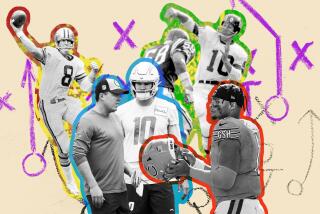Popping up: ‘bubble screen’
- Share via
Each year, football announcers seem to latch on to a phrase and use it over and over, even though some might not even know what it means. This season, it seems, that phrase is “bubble screen.”
So what is a bubble screen?
It’s a pass thrown behind the line of scrimmage to a receiver or running back who’s already in an extended formation. The term “bubble” refers to the pass catcher bubbling back away from the line of scrimmage to give the quarterback a better angle to throw to him.
The goal is to have the receiver catch the ball in front of him, with his shoulders facing forward. At the same time, the receivers outside of him are blocking down the field.
The timing is crucial, because those outside receivers cannot start blocking until the ball has been caught. Otherwise, it’s offensive pass interference. (Typically, officials won’t call that as long as the ball has left the quarterback’s hand.)
Bubble screens are nothing new, even though it’s become a fashionable buzz phrase. They’re essentially glorified sweeps, so they’re usually called in running situations.
When are bubble screens most effective?
They work best when the opposition is caught between sound run and pass schemes. When a defense puts eight players in the box against seven blockers -- five offensive linemen, a tight end and a fullback -- yet tries to keep two safeties back, it can be susceptible.
Often, in those cases, it’s the outside receiver who blocks down on a linebacker who has split the difference between the tackle and the inside (bubble) receiver.
A well-executed bubble screen can pick up four or five yards, and sometimes much more.
More to Read
Go beyond the scoreboard
Get the latest on L.A.'s teams in the daily Sports Report newsletter.
You may occasionally receive promotional content from the Los Angeles Times.











